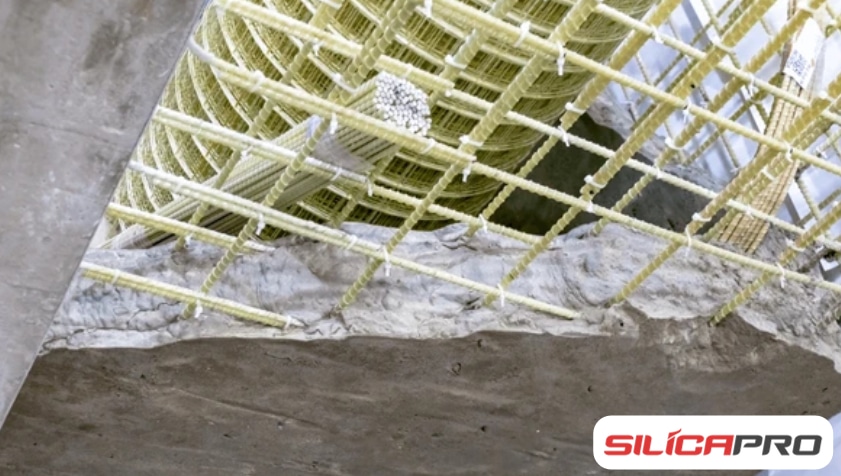
Glass Fiber Reinforced Polyester (GFRP) is a composite material that combines the strength of glass fibers with the flexibility and durability of polyester. Designed to be strong, lightweight, and corrosion-resistant, GFRP is widely used across various industries, from construction to automotive manufacturing, thanks to its resistance to chemical exposure and excellent elasticity.
Contents
How is Glass Fiber Reinforced Polyester Made?
The manufacturing process of GFRP involves several key steps to ensure that the final product meets high standards of durability and performance:
- Glass Fiber Selection: The process begins with selecting glass fibers, which come in rolls or sheets, as the primary reinforcement.
- Polyester Coating: The glass fibers are coated with unhardened polyester to flatten and encase the fibers within a matrix. This initial layer is critical in forming a composite structure.
- Polymerization: The coated material undergoes a polymerization process, where the polyester matrix hardens to form a solid structure that binds the fibers.
- Molding: The hardened material is then placed into a mold to achieve the desired shape, with additional pressing or compaction as needed.
- Heating for Solidification: The molded material is heated to complete polymerization and ensure a strong, stable structure.
- Finishing and Cutting: After heating, the GFRP is cut to specifications, and any finishing processes, such as smoothing or surface treatment, are completed.
- Quality Testing: Finally, the product undergoes rigorous testing to confirm that it meets established standards in strength, endurance, and overall quality.
Now, let’s examine the diverse uses of GFRP and how it compares to other popular composite materials.
Uses of Glass Fiber Reinforced Polyester
GFRP’s combination of tensile strength from glass fibers and durability from polyester makes it suitable for a wide range of applications:
- Structural Construction
GFRP is widely used in building structures like bridges, stairways, and support elements due to its superior strength and corrosion resistance. It provides a strong alternative to traditional materials like steel, especially in environments prone to corrosion.
- Automotive Industry
GFRP is utilized in automotive parts, including body panels, bumpers, and interiors. Its lightweight nature reduces vehicle weight, improving fuel efficiency while maintaining the strength needed for automotive components.
- Sports Equipment
GFRP’s strength and rigidity make it an ideal material for sports equipment such as tennis rackets, darts, and surfboards. It provides the necessary durability while keeping equipment lightweight and manageable.
- Storage Tanks
GFRP’s corrosion resistance makes it a practical choice for storage tanks that hold chemicals and other liquids, protecting against deterioration from corrosive substances.
- Marine Industry
In the marine sector, GFRP is frequently used to build boats, ships, and marine structures due to its excellent resistance to seawater corrosion, ensuring longevity in harsh marine environments.
- Panels
Wall panels made from GFRP offer both strength and structural support, making them suitable for construction and other applications where durability and impact resistance are essential.
- Chemical Industry
GFRP is used in chemical storage tanks and equipment that require resistance to corrosive chemicals. Its durability under chemical exposure makes it a staple in the chemical industry.
Differences Between GFRP and Other Composite Materials
Each composite material offers unique advantages and is suited to different applications. Here’s how GFRP compares to other widely used composites:
- Glass Fiber Reinforced Plastic (GRP)
The terms GFRP and GRP are often used interchangeably. Technically, GRP encompasses any glass fiber reinforced with a plastic matrix, while GFRP specifically refers to composites with a polyester matrix. Therefore, GFRP is a subcategory within the broader GRP classification.
- Carbon Fiber Reinforced Polymer (CFRP)
Unlike GFRP, CFRP uses carbon fibers as the reinforcement. CFRP has a higher tensile strength and stiffness than GFRP, making it ideal for applications requiring exceptional strength. However, it is generally more expensive, limiting its use to high-performance applications.
- Fiberglass Reinforced Plastic (FRP)
FRP is a general term covering various composite materials made from reinforcing fibers (including glass fibers) and a plastic matrix. GFRP is a specific type of FRP that uses glass fibers with a polyester matrix, offering a balance of cost and durability.
- Aramid Fiber Reinforced Polymer (AFRP)
AFRP uses aramid fibers like Kevlar or Nomex, providing high impact resistance and durability. While more costly than GFRP, AFRP is used where high tensile strength and impact resistance are crucial, such as in aerospace and protective equipment.
- Aluminum Composite Material (ACM)
ACM consists of a thin layer of aluminum sandwiched between other materials, usually polymers. It offers high structural stability but differs from GFRP as it doesn’t rely on fibers for its strength. ACM is typically used in applications where rigidity and a lightweight structure are essential.
- Wood-Plastic Composite (WPC)
WPC combines wood fiber or wood powder with a plastic matrix, creating a material with a natural appearance and feel. Although less durable than GFRP, WPC is often used in outdoor decking, fencing, and landscaping applications for its aesthetic qualities.
Conclusion
Glass Fiber Reinforced Polyester (GFRP) is a versatile composite material that provides high strength, corrosion resistance, and flexibility. Its wide range of applications—from structural construction to the automotive and chemical industries—showcases its reliability and cost-effectiveness. Compared to other composite materials, GFRP offers a unique balance of affordability and durability, making it an attractive choice for projects that demand both performance and resilience.
